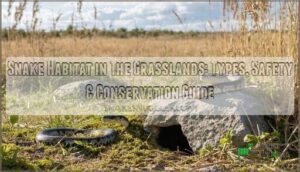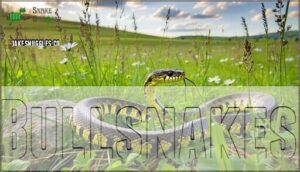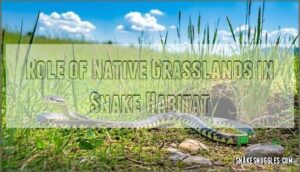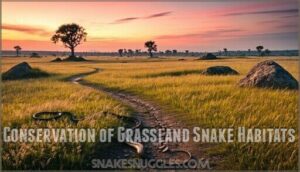This site is supported by our readers. We may earn a commission, at no cost to you, if you purchase through links.
 You’ll find snake habitat in the grasslands is surprisingly diverse.
You’ll find snake habitat in the grasslands is surprisingly diverse.
Prairie rattlesnakes, bullsnakes, and racers call these open spaces home, using burrows, rock piles, and tall grass for shelter.
These serpents have mastered life in wide-open terrain where summer heat can be brutal and winter brings freezing temperatures.
They’ve adapted clever hunting strategies, like ambushing rodents along well-worn trails.
What’s fascinating is how they handle grassland fires – some species actually benefit from the fresh growth that follows.
The key to their survival lies in finding the right balance between hunting grounds and safe retreat sites.
Table Of Contents
- Key Takeaways
- Characteristics of Grassland Snakes
- Types of Snakes in Grassland Habitats
- Habitat Selection and Use
- Avoiding Snake Encounters in Grasslands
- Snake Bite Symptoms and Treatment
- Conservation of Grassland Snake Habitats
- Frequently Asked Questions (FAQs)
- What is the grassland snake habitat?
- Can you find snakes in grasslands?
- What type of habitat does a snake live in?
- What do snakes eat in grasslands?
- What type of snakes live in the grasslands?
- What is snake main habitat?
- Do reptiles live in grasslands?
- How do snakes adapt to temperature changes in grasslands?
- What are the main threats to grassland snake populations?
- How do snakes use different microhabitats within grasslands?
- Conclusion
Key Takeaways
- You’ll find diverse snake species in grasslands including prairie rattlesnakes, bullsnakes, and racers that use burrows, rock piles, and tall grass for shelter and thermoregulation.
- You can identify snake habitats by looking for retreat sites like rocky outcrops, abandoned burrows, dense vegetation, and areas near water sources where they hunt and regulate body temperature.
- You should wear sturdy boots, stay on trails, and watch for warning signs like shed skins, disturbed ground, or unusual scents when exploring grasslands to avoid dangerous encounters.
- You’re witnessing critical habitat loss from agriculture and development that threatens snake populations, making conservation efforts like habitat restoration and protected corridors essential for ecosystem balance.
Characteristics of Grassland Snakes
You’ll discover that grassland snakes have adapted remarkable features to thrive in open terrain, from heat-sensing abilities in rattlesnakes to the lightning-fast speed of racers.
These reptiles showcase unique characteristics like specialized camouflage patterns and varied hunting strategies that make them perfectly suited for life among the grasses and wildflowers, with remarkable features that aid their survival.
Types of Snakes Found in Grasslands
What types of snakes call grasslands home? You’ll discover fascinating grassland snakes with diverse characteristics and behaviors.
- Rattlesnake Varieties like prairie rattlesnakes use potent venom for hunting
- Non-Venomous Snakes including bullsnakes can reach impressive 8-foot lengths
- Racer Behavior demonstrates swift hunting techniques in open prairies
From Coral Snake ID patterns to Moccasin Habitats near water sources, these snake species grasslands showcase remarkable adaptations for grassland reptile habitat survival.
Garter snakes are widespread and can be found in various grassland habitats.
Snake Habitats and Behavior in Grasslands
Grassland snakes expertly navigate their open environments through specialized behaviors and adaptations.
These reptiles rely on thermoregulation by basking on warm rocks or retreating to cool burrows throughout the day.
Snake movement patterns follow prey availability, with hunting behavior focused on rodents and insects.
Most species establish solitary territories, avoiding social interactions except during mating season.
When winter arrives, they seek hibernation sites in deep burrows or rock crevices for survival.
Impact of Climate on Grassland Snakes
Climate shifts reshape grassland snake lives dramatically. Temperature Changes trigger earlier spring emergence, while Rainfall Patterns affect winter survival rates. Habitat Shifts push some species northward as Extreme Weather increases mortality.
Climate change forces grassland snakes to adapt or perish as their ancient habitats transform.
Here’s how climate change impacts grassland snakes:
- Winter survival drops 68% over six decades due to less insulating snow
- Summer activity extends, improving body condition but not offsetting losses
- Prey Availability fluctuates with changing seasonal patterns
- Snake ecology grasslands face unprecedented disruption from warming trends
Rising temperatures may force snakes to undergo significant habitat shifts.
Unique Features of Grassland Snakes
You’ll notice grassland snakes have evolved fascinating features for survival.
Their pupil shape varies—round pupils in grass snakes versus vertical slits in vipers. Color variation ranges from olive-green to brown, providing perfect camouflage.
Size dimorphism shows females growing larger than males, while diet diversity spans from amphibians to rodents.
Lifespan variation differs substantially between species.
- Thermal Masters – They’ll bask on sun-warmed rocks, then retreat to cool burrows
- Living Rulers – Their belly scales help measure distances while slithering
- Chemical Detectives – They taste the air with forked tongues to track prey
Types of Snakes in Grassland Habitats
You’ll encounter several snake species when exploring grassland habitats, each adapted to thrive in these open environments.
From venomous rattlesnakes to harmless constrictors, these reptiles play vital roles in maintaining the grassland ecosystem’s balance.
Western Diamondback Rattlesnakes
You’ll encounter the Western Diamondback Rattlesnake across grassland habitats, where its venom composition makes it a formidable predator.
This species exhibits classic rattlesnake behavior, using its rattle as a warning system.
Their diamondback diet consists primarily of rodents and small mammals.
With a broad habitat range spanning southwestern grasslands, their conservation status remains stable, though habitat protection guarantees these grassland snakes continue thriving in their natural snake habitats.
Prairie Rattlesnakes
Prairie rattlesnakes call areas like the Northern Tulare Basin home, thriving in grassland habitats where they’ve mastered survival.
You’ll find these venomous grassland snakes displaying remarkable predatory behavior as they hunt their preferred snake prey grasslands offer.
They often exhibit burrowing and hiding to escape predators.
Here’s what makes them unique:
- Venom Composition: Potent hemotoxic blend requiring immediate medical attention
- Diet Specifics: Primarily rodents, ground-dwelling birds, and small mammals
- Conservation Status: Generally stable but habitat loss threatens local populations
Bullsnakes
You’ll find bullsnakes are nature’s gentle giants in grasslands.
These non-venomous constrictors can stretch over six feet long but won’t harm you.
They’re actually your allies, controlling rodent populations that damage crops and spread disease.
| Bullsnake Feature | Description |
|---|---|
| Size | 4-8 feet long, powerful build |
| Pattern | Yellow-brown with dark blotches |
| Habitat | Burrows, rock piles, tall grass |
| Diet | Rodents, ground-nesting birds |
| Behavior | Hisses loudly when threatened |
Bullsnake identification is straightforward – look for their distinctive blotched pattern and thick body.
Despite bullsnake myths suggesting they’re dangerous, these grassland snakes are completely harmless.
Their bullsnake behavior includes impressive defensive displays, but they rarely bite.
Bullsnake conservation benefits entire ecosystems since they control snake prey populations naturally.
Eastern Yellow-Bellied Racers
Watch Eastern Yellow-Bellied Racers streak across grasslands like lightning bolts—their Racer Speed reaches impressive velocities when hunting.
These grassland snakes showcase remarkable Racer Behavior in snake habitat grasslands, pursuing prey with relentless determination.
Racer Conservation efforts focus on:
- Protecting grasslands from habitat fragmentation
- Studying Racer Diet patterns and prey relationships
- Expanding Racer Range through corridor restoration
Other Snake Species in Grasslands
Beyond racers, you’ll discover remarkable grassland snakes like moccasins and coral snakes.
Gopher snakes and green snakes showcase incredible snake diversity in these snake habitats.
Each species adapts unique snake diets – from rodent control to amphibian hunting.
These snake species demonstrate nature’s clever survival strategies across grasslands, proving there’s always more than meets the eye.
Habitat Selection and Use
When you’re exploring grasslands, you’ll quickly notice that snakes don’t just randomly pick any spot to call home.
These reptiles are surprisingly picky about their real estate, choosing locations based on specific factors like terrain features, available shelter, and proximity to food sources.
They consider various elements, but the key factor is the presence of shelter.
Factors Influencing Snake Habitat Choice
When grassland snakes choose their homes, they’re like picky house hunters with specific must-haves.
Terrain Preference tops their list—rocky outcrops and gentle slopes offer perfect basking spots.
Water Access within striking distance keeps them hydrated, while Prey Abundance guarantees dinner’s always nearby.
- Vegetation Density: Dense grass provides cover from aerial predators
- Retreat Availability: Burrows and rock crevices offer escape routes
- Habitat Fragmentation: Continuous grasslands beat scattered patches
Importance of Retreat Sites for Snakes
Think of retreat sites as snake apartments—essential for survival.
Grassland snakes rely on burrow usage, rock shelters, and shrub cover for thermoregulation sites and hibernation spots.
Without these cozy hideouts, they’d struggle with temperature control and predator protection.
These retreat sites make snake habitat selection possible in open grasslands.
Retreat Site Types Retreat Site Density Retreat Site Size
Role of Native Grasslands in Snake Habitat
Native grasslands serve as vital lifelines for grassland snakes, providing the foundation they need to thrive.
These ecosystems create perfect conditions where snakes can:
- Find abundant prey – from rodents to amphibians in complex grassland food webs
- Access diverse shelter – burrows, rock crevices, and vegetation for protection
- Regulate body temperature – open areas for basking and shade for cooling
Without healthy native grasslands, snake populations struggle against habitat fragmentation effects and climate change pressures.
Impact of Human Activities on Snake Habitats
Human activities are drastically reshaping grassland snake habitats.
Agricultural expansion converts native grasslands to farmland, while urban development fragments remaining habitat patches.
Chemical pollution from pesticides reduces prey availability and directly harms snakes.
Climate change alters temperature and precipitation patterns that snakes depend on.
These human activities impact creates isolated populations vulnerable to local extinction, making habitat fragmentation a critical threat to grassland snakes survival.
Avoiding Snake Encounters in Grasslands
Exploring grasslands can put you face-to-face with various snake species that call these open habitats home.
You’ll want to know how to spot potential snake hangouts and recognize warning signs before you accidentally disturb a basking rattlesnake or step too close to a hidden bullsnake.
Safety Precautions When Walking in Grasslands
When exploring grassland areas, proper preparation can prevent dangerous snake encounters.
Sturdy footwear protects your feet from potential bites, while maintaining awareness of surroundings helps you spot snakes before they spot you.
Consider exploring options for durable hiking footwear before venturing out.
- Wear thick boots or hiking shoes for protection
- Stay on established trails whenever possible
- Watch for identifying tracks and shed snake skins
- Carry a walking stick to probe ahead in tall grass
- Know immediate action steps if snake bites occur
How to Identify Snake Habitats in Grasslands
Grasslands offer plenty of hiding spots where snakes feel at home.
You’ll find retreat sites like rock piles, abandoned burrows, and dense shrub clusters that provide perfect cover.
Areas with moderate vegetation density attract snakes since they balance shelter with hunting opportunities.
Water sources like ponds or streams are snake magnets, especially for species that hunt amphibians.
Look for thermoregulation spots where snakes bask—sunny rock faces or edge composition areas where grassland meets forest provide ideal temperature control zones.
Warning Signs of Snake Presence in Grasslands
Looking for shed skins near rocks or snake tracks in dusty soil gives you early warning.
Unusual scents like musk or disturbed ground around burrows signal snake presence.
When prey absence creates unusual quiet and you notice fewer small mammals, it often means grassland snake predators are nearby.
Recognizing snake slither tracks can further confirm their presence.
These warning signs help prevent unexpected snake encounters and snake sightings grasslands.
Snake Bite Symptoms and Treatment
While most grassland snake encounters end harmlessly, knowing how to recognize and respond to a bite can save your life.
You’ll need to identify symptoms quickly and take immediate action, as the severity depends entirely on whether you’ve encountered a venomous species.
Common Symptoms of Snake Bites
Snake bite symptoms can range from minor local reactions to life-threatening systemic effects depending on venom variations and bite severity.
When a snake strikes, you’ll notice these key signs:
- Immediate pain and burning at the bite site with visible puncture marks
- Rapid swelling and redness spreading from the wound area
- Nausea, dizziness, and difficulty breathing as venom circulates
- Psychological impact including panic and confusion affecting judgment
The medical treatment you’ll need depends entirely on the snake species involved, which determines the necessary medical treatment.
First Aid for Snake Bites
When faced with a snake bite emergency, your quick response can save someone’s life.
Here’s your essential first aid checklist:
- Call 911 immediately – Professional medical treatment and antivenom therapy are critical
- Keep the victim completely still – Movement accelerates snake venom circulation through the body
- Remove jewelry and tight clothing – Swelling often occurs rapidly around the wound area
- Monitor breathing and pulse – Post-bite monitoring helps track the victim’s condition until help arrives
Never use tourniquets or attempt venom identification yourself – focus on wound care basics and getting professional help fast.
A snake bite kit can also be a valuable asset in these situations.
Medical Treatment for Snake Bites
Once you’ve received first aid, professional medical care becomes your lifeline. Hospital teams quickly assess bite severity and identify venom types to determine the right treatment path.
Antivenom therapy works like a specialized key, activating your body’s defense against snake venom’s harmful effects.
Treatment access varies by location, but antivenom efficacy remains high when administered promptly. Medical teams monitor your signs, manage pain, and watch for long-term effects.
They’ll track your recovery progress while ensuring complications don’t develop from the snake bite incident, providing professional medical care and ensuring the best possible outcome with antivenom therapy and careful monitoring of bite severity.
Importance of Seeking Medical Attention
When dealing with snake bites, time isn’t on your side.
Quick medical attention can mean the difference between recovery and serious complications. Here’s why you shouldn’t hesitate:
- Venom Effects spread rapidly through your bloodstream, causing tissue damage
- Bite Severity varies wildly – even "dry bites" need professional evaluation
- Antivenom Treatment works best when administered within hours of the bite
- Long-Term Effects can include permanent nerve damage without proper care
Globally, snake bites can lead to significant annual fatalities.
Conservation of Grassland Snake Habitats
You’re witnessing one of nature’s most pressing conservation challenges as grassland snake habitats disappear at an alarming rate across North America.
These essential ecosystems face threats from agriculture, urban development, and climate change that put entire snake populations at risk.
Threats to Grassland Snake Habitats
Everyone knows grassland snakes face serious challenges today.
Agricultural expansion and human development cause massive habitat fragmentation, breaking up their homes into tiny pieces.
Climate change shifts weather patterns they’ve adapted to over centuries.
Invasive species compete for food and space.
Industrial farming practices destroy native vegetation they need for shelter and hunting.
Importance of Protecting Snake Habitats in Grasslands
Grassland snake-habitat protection serves as ecosystem balance’s cornerstone, supporting biodiversity through natural pest control.
You’re witnessing conservation efforts that maintain food webs—snakes control rodent populations while serving as prey themselves.
Habitat restoration and sustainable practices prevent snake habitat loss, ensuring grassland ecosystems thrive.
Without grassland snake conservation, you’d face ecological chaos and increased agricultural pests, highlighting the importance of ecosystem balance.
Strategies for Conserving Grassland Snake Habitats
You can’t protect what you don’t actively manage.
Habitat Restoration through rotational mowing every 2-3 years maintains essential vegetation structure while Sustainable Grazing practices prevent overuse.
Establishing Protected Areas with habitat corridors connects breeding and foraging sites, building Climate Resilience.
Public Awareness campaigns reduce snake persecution—many people kill snakes unnecessarily out of fear.
To effectively manage habitat restoration, consider using specialized restoration equipment.
These grassland snake conservation efforts require habitat protection strategies that balance human needs with wildlife survival for effective snake habitat conservation.
Role of Research in Snake Conservation
Research reveals snake conservation secrets through genetic studies and habitat association patterns.
Scientists track population dynamics and restoration impact to guide management practices.
You’ll discover how grassland snake research shapes conservation strategies—from identifying critical habitats to monitoring ecosystem health.
These findings help protect grassland ecosystems and guarantee effective snake habitat conservation strategies for future generations.
Frequently Asked Questions (FAQs)
What is the grassland snake habitat?
You’ll find snakes thriving in grasslands where they use burrows, rocks, and shrubs as retreat sites, hunt small mammals and amphibians, and seek woody cover for thermoregulation.
Can you find snakes in grasslands?
Yes, you’ll find numerous snake species thriving in grasslands! Western diamondback rattlesnakes, prairie rattlesnakes, bullsnakes, and eastern yellow-bellied racers all call these habitats home, using burrows and vegetation for shelter.
What type of habitat does a snake live in?
Snakes adapt to diverse habitats from wetlands to deserts.
But you’ll find them thriving in grasslands where they hunt rodents, birds, and amphibians.
While using rocks, burrows, and shrubs for shelter and thermoregulation.
What do snakes eat in grasslands?
You’ll discover grassland snakes feast on small mammals, birds, amphibians, reptiles, insects, and eggs. They’re nature’s pest controllers, hunting rodents while maintaining ecological balance in their habitat.
What type of snakes live in the grasslands?
Like a needle in a haystack, you’ll spot various species thriving in grasslands.
Western diamondback rattlesnakes, prairie rattlesnakes, bullsnakes, eastern yellow-bellied racers, water moccasins, and grass snakes all call these habitats home.
What is snake main habitat?
You’ll find snakes thriving in diverse habitats where they can hunt, hide, and regulate body temperature.
They prefer areas with retreat sites like burrows, rocks, and dense vegetation for protection and thermoregulation opportunities.
Do reptiles live in grasslands?
Surprisingly, you’ll find grasslands teeming with reptiles! Snakes like rattlesnakes and bullsnakes thrive there, while lizards bask on rocks. These scaly residents have perfectly adapted to open prairie life.
How do snakes adapt to temperature changes in grasslands?
You’ll notice snakes use behavioral tricks to handle grassland temperature swings.
They bask on rocks during cool mornings, then retreat to burrows or shade when it’s hot.
This keeps their body temperature just right.
What are the main threats to grassland snake populations?
You’d think creatures so perfectly adapted to grasslands would thrive, but habitat loss from agriculture, urban development, and climate change devastate snake populations, while fragmentation isolates breeding groups dangerously.
How do snakes use different microhabitats within grasslands?
You’ll observe snakes using grasslands like a multi-story apartment building.
They hunt in open areas, bask near rocks for warmth, hide under vegetation for cover, and retreat to burrows when threatened or resting.
Conclusion
When researchers tracked a prairie rattlesnake through GPS collars, they discovered it traveled over two miles between winter den sites and summer hunting grounds.
Understanding snake habitat in the grasslands helps you appreciate these remarkable journeys.
Whether you’re hiking, photographing wildlife, or managing land, respecting these spaces protects both you and the snakes.
These grassland ecosystems depend on snakes for rodent control, while snakes need undisturbed areas to thrive. Your awareness makes coexistence possible.
- https://www.ideals.illinois.edu/items/31177
- https://www.nachusagrasslands.org/nachusa-blog/snakes-and-prairie-restoration
- https://outdoor.wildlifeillinois.org/articles/snakes-and-prairie-restoration-at-nachusa-grasslands
- https://en.wikipedia.org/wiki/Grass_snake
- https://dipperanch.blogspot.com/2015/06/grassland-snakes-of-santa-cruz-mountains.html


















